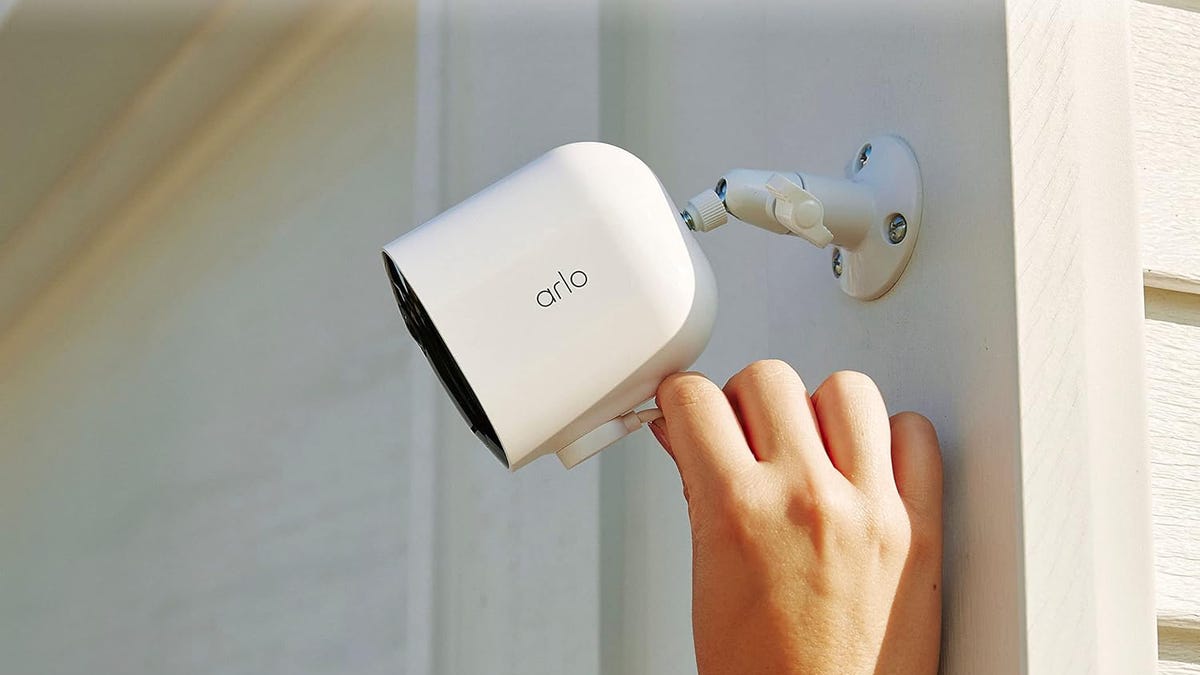Wyze Cam v2: Wyze cams have a lot to love, particularly their low prices and user-friendly interfaces, which is why models like the Cam v2 have qualified as previous top picks. Over the past several years, Wyze has encountered a string of security vulnerabilities that don’t seem to be getting any better, including a late 2023 video caching error that had users looking out of strangers’ live views . I'm putting Wyze on hold for now until it’s clear they have security issues sorted out, but if that doesn’t bother you (many brands have periods where they struggle with a vulnerability ), then it could be an option for budget cams.
Lorex 2K Wi-Fi Floodlight Camera (Update: out of stock): My local storage Lorex pick is an all-purpose cam, but Lorex has more role-specific options too. One version I especially liked was the floodlight camera, ideal for position over a garage or patio to get shine extra light on your property. Eufy SoloCam S230 with integrated solar panel : Going solar in the right outdoor spot can help remove battery woes.

Eufy makes this sunny solution simple by combining the cam with a built-in solar panel on top. If you can position it correctly, you may not need to worry about battery life until the middle of winter. Blink Mini 2 : Tiny and super easy to use, I recommend this Blink Mini 2 cam as a good option if you have a rented room or dorm that you want to keep watch over.
The small cam packs a spotlight, audio features, night vision and even has an outdoor option. It’s a potential option for anyone wanting a small, affordable camera..
. although a subscription is necessary to get some important benefits. Hands-on testing is core to my evaluation of any home security products.
When it comes to security cameras, I start by identifying new and test-worthy products from established manufacturers -- cameras you'd be most likely to come across when shopping online or at your local hardware or electronics stores. When these products hit the market, or sometimes even earlier, I get our hands on them and thoroughly test them in a real-home environment over the course of a week. I begin testing by setting the camera up according to the included and/or app instructions, making note of any difficulties encountered along the way.
Once the camera is ready to roll, I evaluate all features, paying close attention to resolution, night vision, notification latency, local or cloud storage and compatibility with smart home ecosystems like Google, Alexa and Apple HomeKit. Such evaluations can take less than a day, but I monitor the camera over a week (or a few months for battery and weather purposes) for a more complete look at the camera's performance day and night. If general use doesn't give me all the data I need, I create a mock situation -- like staging a porch pirate scenario -- to see how quickly and accurately the camera and app send notifications and record the event.
If you want to read more about CNET's review process, check out our in-depth article on how we test home security cameras and video doorbells. There are hundreds of home security cameras on the market, ranging drastically in price, functionality and quality. With all the options, it can be hard to not become overwhelmed fast, especially when you're considering something as important as your home's safety.
After CNET's years of testing home security cameras, I have some tips if you're on the hunt for a new one. Here are a few parameters to consider: Privacy This is a big one. You don't want anyone peeping on your property or hacking into your camera.
Wireless home security cameras can be more susceptible to hacking due to their connectivity to Wi-Fi networks and remote access, especially if you have poor router security. Wired home security cameras that don't use Wi-Fi at all are generally more secure. (Read more about the pros and cons of wired vs.
wireless systems here .) As I mentioned above, data breaches and security vulnerabilities can also be dangerous for your privacy, so it's important to consider a company's recent reputation. Indoor vs.
outdoor One of the first things you'll need to consider is where you want to place your home security cameras. If you want your camera to be located outside, recording your porch or yard, you'll likely want an outdoor camera that's also weather-resistant or features night vision. While many cameras can be used interchangeably for indoor or outdoor purposes, some cameras are solely made for indoor usage , so make sure you're buying cameras that can handle the outdoor elements.
Video resolution Video quality should be a major consideration when buying a home security camera. In simplest terms, your camera won't be effective if the only footage being recorded is grainy and unreadable. The higher the resolution, the better the video quality.
Most home security cameras on the market now have 1,080p resolution, but others have 2K resolution (like the Arlo Pro 4) or 1,536x1,536-pixel resolution (like the Arlo Video Doorbell), and a growing number have embraced 4K . Just remember, the higher the video quality, the more bandwidth it takes up and the more likely your camera is to experience lag times or glitches. Field of view Field of view (usually provided diagonally) refers to how broad the camera's view is.
Broader is generally better because it captures more space and makes it easier to spot activity. The average security camera tends to top out around 130 degrees, although some go beyond that. Pan and tilt features make the field of view less important since the camera can move around.
I find a broad field of view is great if you want to survey multiple corners of a backyard -- less important if you just want to keep eyes on packages and guests right in front of your door. Battery or wired power Battery and wireless cameras versus wired options are a matter of taste since both types have pros and cons . Wireless options are usually easier to install and operate, and often use cloud storage, so you can access your footage from anywhere.
Wireless security cameras have their own power supply, so even during an internet or power outage, they can still record and save footage. One of the biggest disadvantages is that you'll need to manually change the batteries or charge them every so often unless you get a solar-powered home security camera . Wired cameras are hardwired to a steady connection, so they don't need to be recharged and can often boost a high-quality video resolution.
They tend to be more reliable, secure and consistent in video quality while not requiring monthly cloud storage fees. However, not all owners will feel comfortable wiring in a camera without a pro's help, and they're not great options for renters and people living in apartments . Local vs.
cloud storage Not all video storage is equal. You have two main options and picking one is up to your personal preference. There's cloud storage, which sends your video footage to a remote server to be saved, and local storage, which relies on a separate accessory or piece of hardware, usually a microSD card, to hold any footage you'd like to save.
Usually, cloud storage requires a monthly fee. Wi-Fi quality and range When you're installing wireless home security cameras , keep in mind that the smart home camera you buy (and your security system as a whole) will only be as good as the quality of your Wi-Fi connection at the location where you plan to install it. So check your Wi-Fi speed before you drill holes in the walls or otherwise mess up your door frame, brick or siding for your home security camera.
If the connection is spotty on your wireless security camera, you'll notice significant lag times, pixelation in the live feed and other Wi-Fi delays. These make the video quality poor and home security cameras a pain to use. With a good Wi-Fi connection, you should be in good shape to use your indoor home security camera or outdoor home security camera without any major camera system issues and get clear footage every time.
Still have questions? Take a look at my home security camera buying guide and the below FAQs. Home security cams can be either shelf/table models, wall/ceiling mounts or a combination of both. Cams that offer both options are common, but some are made only for wall mounts.
The best cameras tend to stay away from adhesives that can fade over time. Instead, they use a few simple screws to attach a base plate to wooden trim or posts: Brick, stone, fiber cement and other materials tend to make poor cam placement options without extra work. My guide on placing security cams has more info on where they are best used.
Choosing a home security camera can be overwhelming, with options ranging from professional systems like ADT and Vivint to standalone DIY devices like Blink and Arlo cameras, sensors and locks. The first decision you'll need to make is whether you're looking for a professionally installed system or a DIY security system. The next decision you'll have to make involves the device's specs and features.
Do you want live streaming? Is two-way talk a priority? What about night vision? Modern home security cameras are loaded with neat extra features: motion detection, professional monitoring, push notifications, cloud video storage, weather resistance, sound and motion alerts and integration with third-party devices. Narrowing down which smarts you want your device to have will help you make a final decision. I get this question frequently, and the answer is complicated.
Many security cameras come with an option to record sound along with video by default, as well as a way to turn it off. Some few disable this feature altogether. The reason is that laws about recording sound (like conversations) vary from state to state and country to country.
Most wiretapping laws also affect home devices, often requiring you to have two-party consent before legally recording. That makes this a very gray area, especially if you want to use footage as evidence. You can always use live two-way audio without recording to avoid legal issues.
Some do, but you’ll have to check the specifics. Look up your current security system and see if any other brands or cameras are compatible with your app, panel and hub. For example, Vivint has a “Works with Vivint” page that discusses how you can use Google Home, Amazon Alexa and Philips Hue devices (among others) with the Vivint platform.
Don’t assume that a device will work with your security system. Always get the details first, and call support if necessary. Matter is a compatibility and security protocol, offering a key upgrade for smart homes by addressing long-standing issues with data security and platform support.
Matter’s not a high priority for home security cameras right now, because Matter doesn’t currently support video or smart video devices. The standard receives regular updates to support new devices, and once Matter includes security cameras -- an ongoing but delayed effort -- it will become an even more significant factor for smart homes. Many wireless cameras cannot fully function without an internet connection.
Some cameras -- especially those that are part of a larger home security system -- use alternative radio protocols to transfer information. Those cameras will require a separate hub. Other cameras with local storage can continue recording and saving footage -- such as on a microSD card -- even during an internet outage .
Lorex is one of the best brands for avoiding the internet altogether, but it'll take some work. Cameras can really strengthen your home's security, but they can also degrade its privacy. We don't recommend any cameras that have had recent and serious problems with data breaches for that reason.
But as we explain, direct hacking isn't really a concern . There's no need for burglars to hack security cameras, and malware is more likely to infect webcams if it starts causing problems. In reality, your cameras are more likely to be compromised by a monitoring center employee ignoring the law or an ex with access to your login credentials than by a shadowy cybercriminal.
Will you be able to tell if a security camera is actively recording you? That also depends. Most security cameras will include a small light that will turn on when recording, though that may not be a reliable indicator if the camera has been hacked. Others, like Arlo's indoor camera, include design features that make it totally clear when the camera is watching and when it's not.
In general, if you're worried about maintaining your privacy, devices with physical shields are always a solid option. Home security cameras can vary widely in price, ranging anywhere from $30 to thousands for a multi-cam system. Specific prices depends on the services, model, features or video storage you want for your camera.
Home security cameras don't have to be expensive, though. All of the best home security cameras CNET tested fall between the range of $25 and around $250. I'd suggest budgeting around $100 if possible, but my budget camera picks still do a lot with what they cost .
Just keep in mind that many cams require a monthly subscription to unlock important features, so note if there are ongoing costs..
Technology

Best Home Security Cameras of 2025: My Top Picks for Safety and Surveillance

Our CNET experts tested the latest, smartest security cams to find the models that work best in your home.















